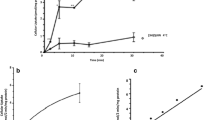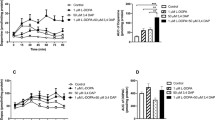Abstract
Lathyrism is a non-progressive motor neuron disease produced by consumption of the excitatory amino acid, 3-N-oxalyl-L-2,3-diaminopropanoic acid (β-ODAP). To learn more about the mechanisms underlying Lathyrism three structural analogs of β-ODAP were synthesized. Carboxymethyl-α,β-diaminopropanoic acid (CMDAP) evoked inward currents which were antagonized by APV (30 μM), but not by CNQX (10 μM). N-acetyl-α,β-diaminopropanoic acid (ADAP) evoked no detectable ionic currents but potentiated N-methyl-D-aspartate (NMDA)-activated currents. The potentiation of NMDA currents by ADAP was blocked by 7-chlorokynurenic acid. Carboxymethylcysteine (CMC) did not activate any detectable ionic currents. None of the three β-ODAP analogs produced visible symptoms of toxicity in day old chicks when administered for 2–3 consecutive days. Ligand binding studies demonstrated that all the three compounds were effective to in displacing [3H]glutamate. The maximum inhibition was 92% for CMDAP, 61% for ADAP, 65% for CMC and 99% for β-ODAP. These data indicate that analogs of β-ODAP may interact with glutamate receptors without producing neurotoxicity.
Similar content being viewed by others
REFERENCES
Spencer, P. S., and Schaumburg, H. H. 1983. Lathyrism: A neurotoxic disease. Neurobehav Tox Terat 5:625–629.
Ludolph, A. C., Hugon, J., Dwivedi, M. P., Schaumburg, H. H., and Spencer, P. S. 1987. Studies on the aetiology and pathogenesis of motor neuron diseases 1. Lathyrism: clinical findings in established cases. Brain 110:149–165.
Spencer, P. S., Ludolph, A., Dwivedi, M. P., Roy, D. N., Hugon, J., and Schaumburg, H. H. 1986. Lathyrism: Evidence for role of the neuroexcitatory amino acid BOAA. Lancet i:1066–1067.
Haimanot, R. T., Kidane, Y., Wuhib, E., Kalissa, A., Alemu, T., Zein, Z. A., and Spencer, P. S. 1990. Lathyrism in rural northwestern Ethiopia: A highly prevalent neurotoxic disorder. Int J Epidemiol 19:664–672.
Jayaraman, K. S. 1989. Neurolathyrism remains a threat in India. Nature 339:495.
Haque, A., Hossain, M., Khan, J. K, Kuo, Y. H., Lambein, F. and De Reuck, J. 1994. New findings and symptomatic treatment for neurolathyrism, a motor neuron disease occurring in North West Bangladesh. Paraplegia 32:193–195.
Cohn, D. F., and Streifler, M. 1981. Human neurolathyrism, a follow-up study of 200 patients Part I: Clinical investigation. Arch Suiss Neurol Neuroch Psych 128:151–156.
Cohn, D. F., and Streifler, M. 1981. Human neurolathyrism, a follow-up study Part II: Special investigations. Arch Suiss Neurol Neuroch Psych 128:157–163.
Hugon, J., Ludolph, A., Roy, D. N., Schaumburg H. H., and Spencer, P. S. 1988. Studies on the eitology and pathogenesis of motor neuron diseases. II. Clinical and electrophysiologic features of pyramidal dysfunction in macaques fed Lathyrus sativus and IDPN. Neurology 38:435–442.
Ross, S. M., Seelig, M., and Spencer, P. S. 1987. Specific antagonism of excitotoxic action of “uncommon” amino acids assayed in organotypic mouse cortical cultures. Brain Res 425:120–127.
Nunn, P. B., Seelig, M., and Spencer, P. S. 1986. Acute neuronal changes induced in cortex/cord by “uncommon” plant amino acids. Neuropathol Appl Neurobiol 4:348.
Rao, S. L. N., Adiga, P. R., and Sarma, P.S. 1964. The isolation and characterization of β-N-oxalyl-L-α,β-diaminopropionic acid: a neurotoxin from the seeds of Lathyrus sativus. Biochemistry 3: 432–436.
Zeevalk, G. D., and Nicklas, W. J. 1989. Acute excitotoxicity in chick retina caused by the unusual amino acids BOAA and BMAA: Effects of MK-801 and kynurenate. Neurosci Lett 102:284–290.
Bridges, R. J., Kadri, M. M., Monaghan, D. T., Nunn, P. B., Watkins, J. C., and Cotman, C. W. 1988. Inhibition of [3H]α-amino-3-hydroxy-5-methyl-4-isoxazolepropionic acid binding by the excitotoxin β-N-oxalyl-L-α, β-diaminopropionic acid. Eur J Pharmacol 145: 357–359.
MacDonald, J. F., and Morris, M. E. 1984. Lathyrus excitotoxin: mechanism of neuronal excitation by L-2-oxalylamino-3-amino-and L-3-oxalylamino-2-amino-propionic acid. Exp Brain Res 57:158–166.
Pearson, S., and Nunn, P. B. 1981. The neurolathyrogen, β-N-oxalyl-L-α,β-diaminopropionic acid, is a potent agonist at glutamate preferring receptors in the frog spinal cord. Brain Res 206: 178–182.
Nunn, P. B., Seelig, M., Zagoren, J. C., and Spencer, P. S. 1987. Stereospecific acute neuronotoxicity of “uncommon” plant acids linked to human motor-system disease. Brain Res 410: 375–379.
Ross, S. M., Roy, D. N., and Spencer, P. S. 1989. β-N-Oxalylamino-L-alanine action on glutamate receptors. J Neurochem 53:710–715.
Ross, S. M., and Spencer, P. S. 1987. Specific antagonism of behavioral action of “uncommon” amino acids linked to motor-system diseases. Synapse 1:248–253.
Koh, J., Goldberg, M. P., Hartley, D. M., and Choi, D. W. 1990. Non-NMDA receptor-mediated neurotoxicity in cortical culture. J Neurosci 10:693–705.
Rao, S. L. N. 1978. Entry of β-N-oxalyl-L-α,β-diaminopropionic acid, the Lathyrus sativus neurotoxin into the central nervous system of the adult rat, chick and the rhesus monkey. J Neurochem 30:1467–1470.
Mehta, T., Parker, A. J., Cusick, P. K., Zarghami, N. S., and Haskell, B. E. 1983. The lathyrus sativus neurotoxin: resistance of the squirrel monkey to prolonged oral high doses. Toxicol Appl Pharmacol 69:480–484.
Shasi Vardhan, K., Pratap Rudra, M. P., and Rao, S. L. N. 1997. Inhibition of tyrosine aminotransferase by β-N-oxalyl-L-α,β-diaminopropionic acid, the Lathyrus sativus neurotoxin. J. Neurochem. 68: 2477–2484.
Monaghan, D. T., and Cotman, C. W. 1986. Identification and properties of N-methyl-D-aspartate receptors in rat brain synaptic plasma membranes. Proc Natl Acad Sci USA 83:7532–7536.
Allen, C. N., Omelchenko, I., Ross, S. M., and Spencer, P. 1995. The neurotoxin, β-N-methylamino-L-alanine (BMAA) interacts with the strychnine-insensitive glycine modulatory site of the N-methyl-D-aspartate receptor. Neuropharmacology 34:651–658.
Allen, C. N., Spencer, P. S., Carpenter, D. O. 1993. β-N-methylamino-L-alanine in the presence of bicarbonate is an agonist at non-N-methyl-D-aspartate-type receptors. Neuroscience 54:567–574.
Hamill, O. P., Marty, A., Neher, E., Sakmann, B., and Sigworth, F. J. 1981. Improved patch-clamp techniques for high resolution current recording from cells and cell-free membrane patches. Pflugers Arch 391:85–100.
Coyle, J. T. 1987. Kainic acid: insights into excitatory mechanisms causing selective neuronal degeneration. Ciba Found Symp 126: 186–203.
Lehmann, J., Kerkany, J. W., Schaeffer, P., and Coyle, J. T. 1995. Dissociation between the excitatory and “excitotoxic” effects of quinolinic acid analogs on the striatal cholinergic interneurons. J Pharmacol Exp Ther 232:873–882.
Künig, G., Hartmann, J., Niedermeyer, B., Deckert, J., Ransmayr, G., Heinsen, H., Beckmann, H., and Riederer, P. 1994. Excitotoxins L-β-oxalyl-amino-alanine (L-BOAA) and 3,4,6-trihydroxyphe-nylalanine (6-OH-DOPA) inhibit [3H]α-amino-3-hydroxy-5-methyl-4-isoxazolepropionic acid (AMPA) binding in human hippocampus. Neurosci Lett 169:219–222.
Kunig, G., Hartmann, J., Niedermeyer, B., Deckert, J., Ransmayr, G., Heinsen, H., Beckmann, H., and Riederer, P. 1994. Exctitotoxins L-β-oxalyl-amino-alanine (L-BOAA) and 3,4,6-trihydroxyphenylalanine (6-OH-DOPA) inhibit 3Hα-amino-3-hydroxy-5-methyl-4-isoxazolepropionic acid (AMPA) binding in human hippocampus. Neurosci. Lett. 169:219–222.
Jain, R. K., Junaid, M. A., and Rao, S. L. N. 1998. Receptor in teractions of β-N-oxalyl-L-α,β-diaminopropionic acid, the Lathyrus sativus putative excitotoxin, with synaptic membranes. Neurochem. Res. 23:1191–1196.
Jacob, E., Patel, A. J., and Ramakrishnan, C. V. 1967. Effect of neurotoxin from seeds of Lathyrus sativus on glutamate metabolism in chick brain. J Neurochem 14:1091–1094.
Mehta, T., Hsu, A-F., and Haskell, B. E. 1972. Specificity of the neurotoxin from Lathyrus sativus as an amino acid antagonist. Biochemistry 11:4053–4063.
Rao, S. L. N., and Sarma, P. S. 1964. Neurotoxic properties of N-substituted oxamic acids. Ind J Biochem 3:57.
Benveniste, M., and Mayer, M. L. 1991. Kinetic analysis of antagonist action at N-methyl-D-aspartic acid receptors. Two binding sites each for glutamate and glycine. Biophys J 59:560–573.
Clements, J. D., and Westbrook, G. L. 1991. Activation kinetics reveal the number of glutamate and glycine binding sites on the N-methyl-D-aspartate receptor. Neuron 7:605–613.
MacDermott, A. B., Mayer, M. L., Westbrook, G. L., Smith, S. J., and Barker, J. L. 1986. NMDA-receptor activation increases cytoplasmic calcium concentration in cultured spinal cord neurones. Nature 321:519–522. (Abstract)
Mayer, M. L., MacDermott, A. B., Westbrook, G. L., Smith, S. J., and Barker, J. L. 1987. Agonist-and voltage-gated calcium entry in cultured mouse spinal cord neurons under voltage clamp measured using arsenazo III. J Neurosci 7:3230–3244.
Nicotera, P., Bellomo, G., and Orrenius, S. 1992. Calcium mediated mechanisms in chemically induced cell death. Annu Rev Pharmacol Toxicol 32:449–470.
Zinkand, W.C., Thompson, C., Salama, A.I., and Patel, J. 1992. Excitatory amino acid-evoked calcium influx and calcium-dependent neurotoxicity in rat cortical cultures. Ann NY Acad Sci 648:355–357.
Choi, D. W. 1992. Excitotoxic cell death. J Neurobiol 23: 1261–1276.
Snell, L. D., Morter, R. S., and Johnson, K. M. 1988. Structural requirements for activation of the glycine receptor that modulates the N-methyl-D-aspartate operated ion channel. Eur J Pharmacol 156:105–110.
Bigge, C. F. 1993. Structural requirements for the development of potent N-methyl-D-aspartic acid (NMDA) receptor antagonists. Biochem Pharmacol 45:1547–1561.
McBain, C. J., Kleckner, N. W., Wyrick S., and Dingledine R. 1989. Structural requirements for activation of the glycine coagonist site of N-methyl-D-aspartate receptors expressed in Xenopus oocytes. Mol Pharmacol 36:556–565.
Author information
Authors and Affiliations
Corresponding author
Rights and permissions
About this article
Cite this article
Omelchenko, I.A., Jain, R.K., Junaid, M.A. et al. Neurotoxic Potential of Three Structural Analogs of β-N-oxalyl-α,β-Diaminopropanoic Acid (β-ODAP). Neurochem Res 24, 791–797 (1999). https://doi.org/10.1023/A:1020791815848
Issue Date:
DOI: https://doi.org/10.1023/A:1020791815848




